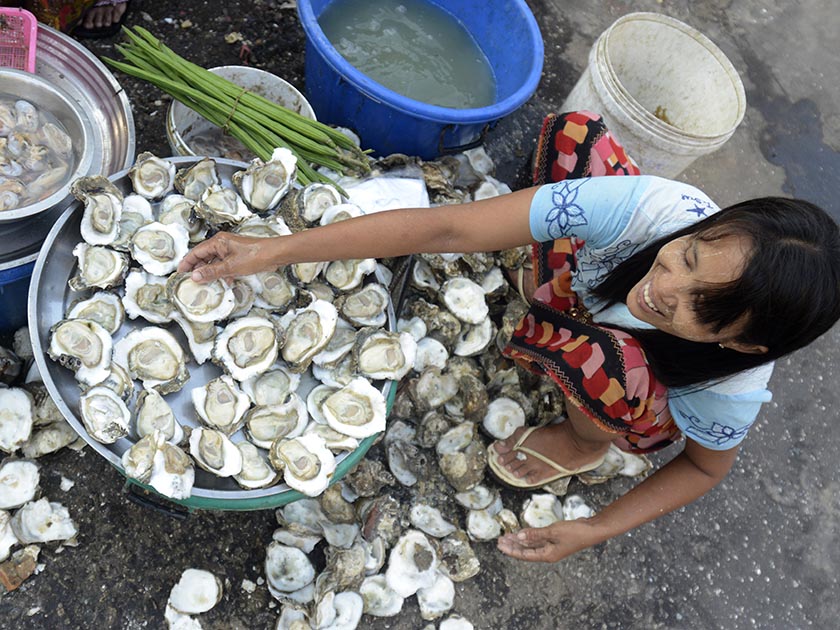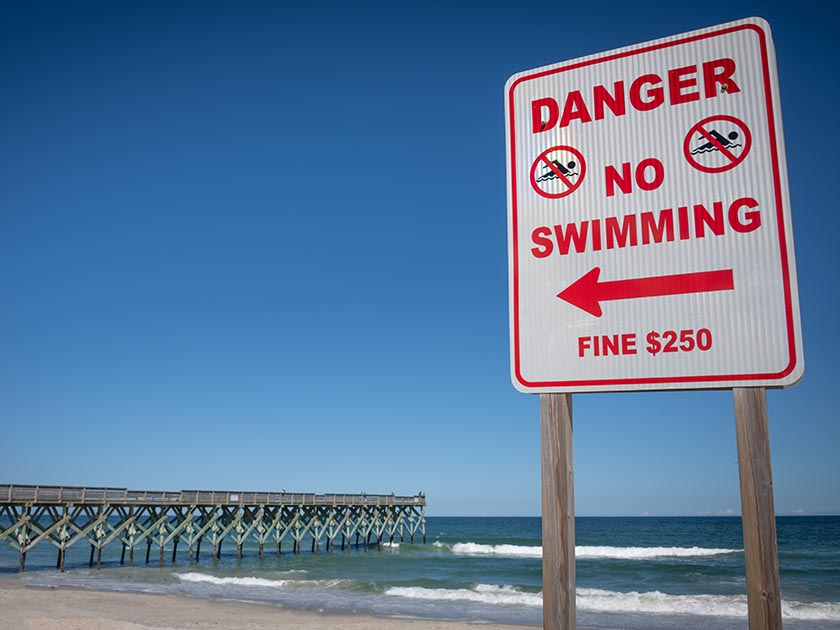This research digest is a synopsis of the study “Coastal urbanization influences human pathogens and microdebris contamination in seafood,” published in Science of the Total Environment in 2020.
Key Findings and Implications:
- As the first study to use emerging technologies to comprehensively identify an array of contaminants in seafood, this study revealed the widespread presence of human bacterial pathogens and human-derived microcontaminants in oysters in Myanmar.
- Both pathogens and microparticle contaminants, such as milk powder from baby food formula, reflect the pervasive presence of sewage in coastal waters, even large distances from the pollution’s source.
- Coastal urbanization and the lack of sewage treatment increases contamination in seafood and can cause potential health risks to humans.
- The implications for other coastal regions are significant, since coastal marine environments worldwide are experiencing reduced water quality from rapid urbanization, and trends may result in the contamination of important fish species.

A street market in Myanmar. Photo: iStock
Oysters pulled from the waters of a rural but rapidly urbanizing area off the coast of Myanmar were found to be laden with disease-causing bacteria and potentially toxic microcontaminants such as plastic, paint, kerosene and talc, revealed a study published in mid-summer 2020 in the peer-reviewed journal Science of the Total Environment.
The researchers identified nearly 5,500 different bacterial pathogens in oyster (Pinctada margaritifera), sediment and seawater samples. They also comprehensively identified 78 different types of microdebris materials, about half of which were plastics, while others included paint, kerosene, talc, and milk supplement powder.
Typically scientists test for only a few specific disease-causing pathogens, as lab tests that allow bacteria to be cultured are available for less than 1 percent of known bacteria.1 Additionally, non-plastic materials are commonly misidentified as plastic.2 In this study, the researchers utilized advanced RNA sequencing and other emerging technologies and techniques to provide one of the first comprehensive snapshots of seafood contaminants.
The study’s samples suggest that pollution from sewage and other human activities may travel much farther and be more prevalent in seafood than previously realized.
Collected from nine coral reef islands in the Mergui Archipelago, roughly 40 miles from the southern city of Myeik (population 250,000), the study’s samples suggest that pollution from sewage and other human activities may travel much farther and be more prevalent in seafood than previously realized. Wastewater carries numerous contaminants including persistent organic pollutants, nutrients, oils, radionuclides, heavy metals, pathogens, sediments, and debris that can affect the marine environment and associated organisms.3 This study focused on pathogens and debris. While the study did not determine the specific level of health risk presented by the contaminants, the results highlight a global pattern of regulatory neglect in the intersecting issues of wastewater, water quality, and seafood contamination.
“We’re very behind in knowing what’s in our food. There is very little understanding about the human health implications of particulates in our food, including seafood.”
“We’re very behind in knowing what’s in our food,” said Dr. Joleah Lamb, of the Department of Ecology and Evolutionary Biology at the University of California, Irvine and senior author of the study. In the United States, roughly 60 percent of our seafood is imported from overseas,4 and “there is very little understanding about the human health implications of particulates in our food, including seafood,” Lamb said.
Among many potentially problematic pathogens the researchers found in the oyster tissue were Clostridium perfringens—annually responsible for millions of cases of foodborne illness worldwide; C. tuberculosos tearicum, which is multi-drug resistant pathogen; and C. aerofaciens, a bacteria linked to inflammatory bowel syndromes such as Crohn’s disease and ulcerative colitis. About half of the microdebris particles identified were plastic, which are capable of absorbing toxic harmful additives and compounds from seawater5 and may also leach toxins into the environment.
Globally, seafood is one of the most-traded food commodities. More than half of seafood exports (by value) originate in developing countries.6 Simultaneously, the world is experiencing a sanitation crisis, with about 4.3 billion people worldwide who do not have access to safe sanitation systems that eliminate contaminants.7
“The potential contaminants found in this study indicate that the Mergui Archipelago in Myanmar has wastewater pollution that can affect downstream food sources spanning over 80 kilometers [50 miles],” the study says.8 “Wastewater treatment in Southeast Asia is estimated at 14 percent.”9
In a local context, seafood contamination could threaten health and livelihoods. Artisanal fishing is one of the major sources of employment in the Mergui Archipelago, with about 10,000 fishing vessels, and these oysters are commonly consumed locally, raw, and whole.10
But it would be a mistake to consider seafood contamination as an issue limited to certain countries, said Dr. Amelia Wenger, a fish ecologist and water quality scientist at the University of Queensland, Australia and coauthor on the study.
“People often think that sewage is a problem in lower-income countries with limited infrastructure.” Wenger said, “But if you look at the amount of effluent that gets directly discharged into the environment in the United States without being treated, it’s astounding,” Wenger said. She cited Hawai’i, where an estimated 88,000 cesspools are still in operation,11 and California, where sewage often contaminates beaches.12 (Cesspools are essentially holes in the ground where human waste is deposited.)
“In California, there are signs on the beaches saying ‘Don’t go swimming’ after it’s been raining, because of the effluent that has been discharged,” Wenger said.
“People often think that sewage is a problem in lower-income countries with limited infrastructure. But if you look at the amount of effluent that gets directly discharged into the environment in the United States without being treated, it’s astounding.”

Photo: iStock
Preliminary data collected by the authors of the study from other regions support the idea that contamination levels found in Myanmar are far from unique. In addition to sewage pathogens showing up in samples from the coasts of Indonesia, Thailand, and China, pathogens have also turned up in a study of mussels pulled from the Puget Sound in the Seattle area of Washington State.
“We’re finding similar levels of potential human pathogens in mussels around Seattle as we’re finding in Myanmar,” said Lamb. The authors are preparing to submit the data and results for publication.
Milk substitute particles found in the oysters
Prior to this study, the authors expected to find significant evidence of plastic contamination. But one of the more surprising findings was that so many of the microdebris particles turned out not to be plastic. For instance, 14 percent of the particles were identified as milk supplement powders from three different brands—products marketed as substitutes for breast milk and fed to babies.
The presence of the milk supplements in the oyster tissue underscores the direct oral-fecal link between sewage and seafood, and highlights how easily these contaminants can evidently make their way into the food chain. Depending on many factors which were not tested in this study, such as concentration or dose, the signs of seafood contamination may pose risks of foodborne illness or disease. These contaminants also raise questions about consumer product safety.
“Usually if you’re drinking milk, you integrate it into your system and it comes out as nutrients,” Wenger said. “The fact that it’s being maintained as a particle that can be pulled out of a sample and identified down to a brand gives you pause as to what is actually in the formula,” Wenger said. “It raises questions such as, ‘How does that baby formula work in humans? And why is it not broken down when it hits the marine environment?’”
“It makes you realize how many pollutants are actually in the water,” Wenger said, “and how long-lasting they are.”
Notes
Report citation: Raechel A. Littman, Evan A. Fiorenza, Amelia S. Wenger, Kathryn L.E. Berry, Jeroen A.J.M. van de Water, Lily Nguyen, Soe Tint Aung, Daniel M. Parker, Douglas N. Rader, C. Drew Harvell, Joleah B. Lamb. “Coastal urbanization influences human pathogens and microdebris contamination in seafood.” Science of the Total Environment (2020) 736: 139081.
- Raechel A. Littman, Evan A. Fiorenza, Amelia S. Wenger, Kathryn L.E. Berry, Jeroen A.J.M. van de Water, Lily Nguyen, Soe Tint Aung, Daniel M. Parker, Douglas N. Rader, C. Drew Harvell, Joleah B. Lamb. “Coastal Urbanization Influences Human Pathogens and Microdebris Contamination in Seafood.” Science of the Total Environment (2020) 736: 139081.
- Ibid.
- Stephanie Wear and Rebecca Vega Thurber. “Sewage Pollution: Mitigation is Key for Coral Reef Stewardship,” Annals of the New York Academy of Sciences (May 8, 2015). https://doi.org/10.1111/nyas.12785.
- Jessica A. Gephart, Halley E. Froehlich, and Trevor A. Branch. “Opinion: To create sustainable seafood industries, the United States needs a better accounting of imports and exports.” Proceedings of the National Academy of Sciences 116 no. 19 (May 7, 2019) 9142-9146. https://doi.org/10.1073/pnas.1905650116.
- M.A. Browne, S.J. Niven, T.S. Galloway, S.J. Rowland, R.C. Thompson, “Microplastic Moves Pollutants and Additives to Worms, Reducing Functions Linked to Health and Biodiversity, Current Biology 23, (2013): 2388–2392.
- F. Asche, M.F. Bellemare, C. Roheim, M.D. Smith, S. Tveteras, “Fair enough? Food security and the international trade of seafood.” World Development 67, (2015) 151–160.
- United Nations Children’s Fund & World Health Organization, “Progress on Household Drinking Water, Sanitation and Hygiene 2000–2017: Special Focus on Inequalities,” (New York, 2019).
- Littman et al, 2020. “Coastal Urbanization Influences Human Pathogens and Microdebris Contamination in Seafood.”
- A.E. Evans, M.A. Hanjra, Y. Jiang, M. Qadir, P. Drechsel, “Water quality: assessment of the current situation in Asia.” International Journal of Water Resources and Development no. 28 (2012): 195–216.
- Tom Vasich, “Plastics, pathogens and baby formula: What’s in your shellfish? New study finds coastal urbanization increases contamination in seafood,” University of California, Irvine News, July 30, 2020.
- Andrea Bertoli, “53 Million Gallons Of Wastewater Flushes Daily Into Hawaii’s Waters — How One Local Non-Profit Is Working To Fix This,” Clean Technica, February 8, 2020, Accessed August 13, 2020. https://cleantechnica.com/2020/02/08/53-million-gallons-wastewater-flushes-daily-into-hawaiis-waters-how-one-local-non-profit-is-working-to-fix/.
- Sam Levin, “Los Angeles Beaches Plagued with Toxic Stormwater, Report Warns,” The Guardian, December 11, 2019.
